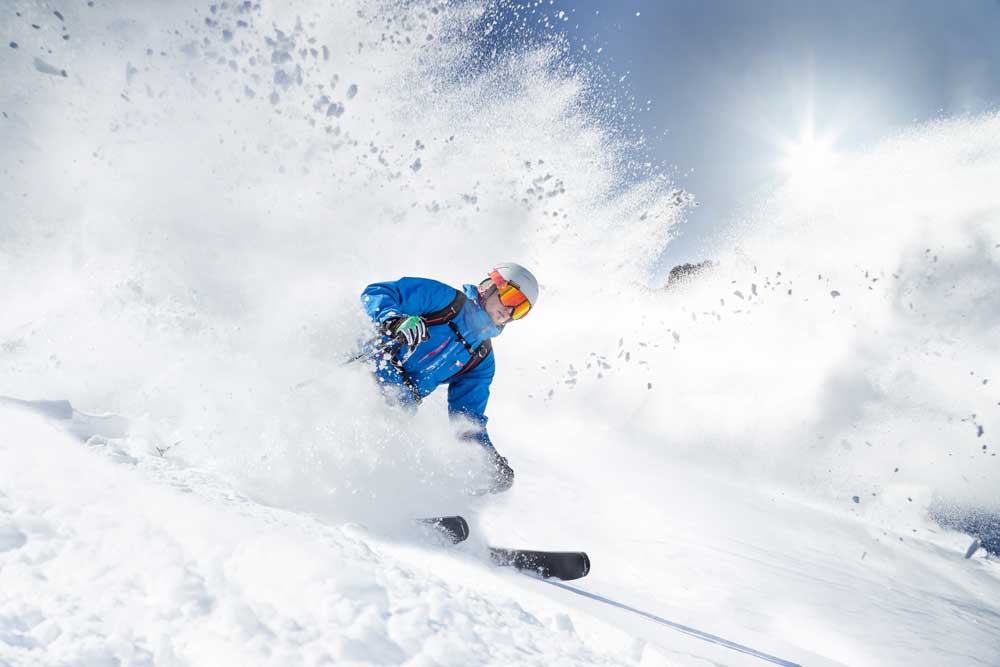Skiing is exhilarating! Whether it is Alpine, Backcountry, or Nordic skiing, getting out on the snow is tremendous fun. Don’t let knee pain or injury ruin the activity.
Skiing can be tough on our knees, whether it is an injury or “worn out painful parts.” Whether you have “tweaked” your knee or are experiencing pain during or after skiing, getting a proper diagnosis can get you back on the right track. In this article, Dr. Phil Davidson highlights the most common knee conditions related to skiing and treatments available to get you back to what you love doing best in the winter!

Good Pain vs. Bad Pain
If you’re a bit sore or have tenderness in your legs after a day on the mountain, don’t panic! The general feeling of soreness in the calf and thigh is typical after skiing. General conditioning, strengthening, and pre-ski warm-up can diminish this soreness moving forward. Massage therapy, application of ice, or stretching can generally treat this discomfort.
However, knee pain that does not go away with the above treatments may be considered more serious.
Knee pain that comes with painful symptoms such as clicking, swelling, popping, and stiffness can signal that the joint is in trouble. If this is the case, then there may be damage to the soft tissues or joint itself. We advise that you seek proper diagnosis and treatment before continuing to ski.
For more on “patellofemoral syndrome,” visit our article here
Common Injuries
Ski injuries are common. Some of the most common injuries we treat are Ligament Injury (particularly ACL and MCL), Torn Meniscus, Patellofemoral Pain, Fractures, and more…
Treatments Options
Fortunately, there are many treatments available to help get you back to the sport you love. Treatments for knee injury and pain include non-invasive and minimally invasive options, depending on the specific diagnosis.
For many injuries and complaints of pain, we often start with relatively straightforward and familiar options, many that you can complete at home:
Apply the RICE method:
- Rest
- Ice
- Compression
- Elevation
Physical Therapy
Knee-friendly stretches and muscle strengthening exercises are effective for mild knee inflammation. You can also introduce adaptive wear, such as a sleeve that goes over the knee, for additional support.
What if Physical Therapy doesn’t work?
Suppose this method does not provide any relief and the pain persists (especially over an extended period). In that case, it is time to schedule a visit to your orthopedic specialist, who will perform an X-Ray and exam to gain insights into your knee condition.
Minimally invasive options:
- Anti-inflammatory medication can be used to alleviate pain and inflammation
- Injection therapies can be used to treat inflammation and promote healing
- Steroids can potently decrease inflammation and are suitable for short term relief
- Hyaluronic Acid can provide knee lubrication and decrease achiness
- PRP (platelet-rich plasma) is derived from the patient’s blood and has the capacity, in certain cases, to promote and accelerate healing
- Stem Cell type therapies are also being selectively used to treat knee injury and degeneration
What if these options don’t work?
If knee pain does not respond to conservative measures or lasts longer than 2-3 months, advanced imaging is frequently needed. Depending upon the exact condition, surgery may be the best option.
Surgery of the knee is typically minimally invasive and performed arthroscopically, thru small portals. The exact surgery and recovery are, of course, specific to each patient and their individual needs.
Our goal is to get you back to experiencing the physical activities that you enjoy when it comes to your orthopedic health.
“I see my job as helping people resume the activities they love. In that respect, what I do is very rewarding”. – Dr. Phil Davidson
About Davidson Orthopedics
 Dr. Davidson has a decades-long commitment to increasing the understanding and treatment options for patients with patellofemoral pain. He is a member of the International Patellofemoral Study Group, an exclusive group of experts dedicated to the study and treatment of patellofemoral problems. He provides comprehensive diagnostics and an ever-increasing roster of treatment options, ranging from relatively simple non-invasive treatments to complex surgical restorations. Of particular excitement in the past few years is the integrated usage of biologic injections into the knee, allowing improvement of the biologic environment within the knee, typically used effectively in conjunction with other modalities, allowing patients to maintain or resume an active lifestyle.
Dr. Davidson has a decades-long commitment to increasing the understanding and treatment options for patients with patellofemoral pain. He is a member of the International Patellofemoral Study Group, an exclusive group of experts dedicated to the study and treatment of patellofemoral problems. He provides comprehensive diagnostics and an ever-increasing roster of treatment options, ranging from relatively simple non-invasive treatments to complex surgical restorations. Of particular excitement in the past few years is the integrated usage of biologic injections into the knee, allowing improvement of the biologic environment within the knee, typically used effectively in conjunction with other modalities, allowing patients to maintain or resume an active lifestyle.
